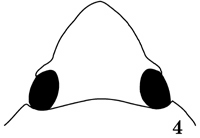anterior claw enlarged in all genera except Stenocrates Burmeister, one
species of Dyscinetus Harold, and Erioscelis Burmeister.
Females: Apex of last abdominal sternite entire, evenly parabolic. Protarsomeres
4-5 and anterior claw always simple, not enlarged.
| 1. . |
Protibia in males slender, strongly curved, with tooth near base; females with protibia normal. Length 35-40 mm | Harposceles
Burmeister |
| 1'. |
Protibia not proportionally slender, not curved, lacking tooth near base. Size variable | . 2 |
| 2(1). . |
Body broad, oval. Color black or reddish brown. Length 14-16 mm | Arriguttia
Martínez |
| 2'. |
Body not distinctly broad, oval. Color variable. Length 5-30 mm | .
|
| 3(2). . . |
Elytra strongly, completely, irregularly punctate; surface yellowish with dark spots, usually with metallic reflection. Apex of clypeus round, margin beneath enlarged | . Augoderia Burmeister |
| 3'. . . . |
Elytra punctate, punctate-striate, or not, but never completely and irregularly punctate; surface yellow or not but never with metallic reflection. Apex of clypeus variable in shape, margin beneath apex only rarely thickened | . |
| 4(3). . |
Body strongly flattened. Size 35-40 mm. Color black. Males with protarsi strongly thickened | Surutu
Martínez |
| 4'. |
Body not strongly flattened. Size less than 30 mm. Color variable. Males with protarsi enlarged or not | |
| 5(4). . |
Clypeus with apex distinctly pointed or narrowly parabolic (Figs. 3-5) | . 6 |
| 5'. |
Clypeus with apex rounded (Fig. 6), truncate (Fig. 7), or emarginate (Fig. 8) but not distinctly pointed or narrowly parabolic | |
 |
 |
 |
 |
 |
|
| 6(5). . . . |
Clypeus with apex sharply acuminate (Fig. 3). Mentum with apex distinctly (but never deeply) emarginate, surface at center not furrowed in apical third (Fig. 9). Base of pronotum with marginal bead. Length less than 16 mm | |
| 6'. |
Clypeus with apex narrowly parabolic (Figs. 4-5). Mentum with apex distinctly (often deeply) emarginate, surface at center furrowed in apical third (Fig. 10). Base of pronotum without marginal bead. Length usually more than 18 mm, rarely as small as 15 mm | |
 |
 |
 |
 |
 |
| 7(6). . |
Prepygidium
with long setae . |
Chalepides
Casey |
| 7'. |
Prepygidium lacking long setae | |
| 8(7). . |
Clypeus with apex transversely subtrapezoidal to trapezoidal in shape (Figs. 11-12) | . 9 |
| 8'. |
Clypeus with apex rounded, truncate, subquadrate or emarginate (Figs. 6-8) | |
 |
 |
 |
 |
 |
|
| 9(8). . . . . . .. |
Clypeus trapezoidal, sides strongly convergent to truncate or feebly emarginate apex, anterior corners angulate (Fig. 12). Frontoclypeal suture distinct, usually broadly depressed just before suture. Pronotum with anterior margin normally arcuate, not produced forward at middle (Fig. 12). Meso- and metafemora and tibiae strongly flattened. Males with protarsomeres simple, not enlarged | |
| 9'. |
Clypeus subtrapezoidal to trapezoidal, sides only gradually convergent to truncate or weakly emarginate apex, anterior corners rounded (Fig. 11). Frontoclypeal suture a finely impressed line but not with deep and broad impression before it. Pronotum on anterior margin produced anteriorly at middle (Fig. 11). Meso- and metafemora and tibiae not strongly flattened. Males with anterior claw and usually protarsomeres 4-5 enlarged | |
 |
 |
| 10(8). . . . |
Clypeus with sides usually divergent (sometimes only slightly) at base, apex broadly rounded (Fig. 13). Maxilla lacking teeth (except for the distinctive Aspidolea fuliginea Burmeister), apex penicillate (setae usually long and dense) | |
 . |
||
| 10'. |
Clypeus with sides parallel or convergent from base (never divergent), apex rounded, subtruncate, or emarginate. Maxilla armed with distinct teeth, only rarely penicillate in addition (a few species of Cyclocephala) | |
| 11(10). . . |
Clypeus subquadrate, sides weakly converging to broad apex, apex truncate or emarginate (Figs. 14-15). Males with protarsus simple, not enlarged | . Erioscelis Burmeister |
| 11'. |
Clypeus not subquadrate, instead with sides converging from base to rounded, parabolic, or emarginate apex (Figs. 6-8). Males with protarsus enlarged | |
 |
 |
 |
 |
 |
|